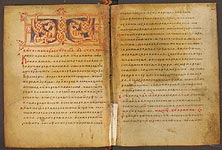Tetraevangelion.
90s. 14th cent. Moscow. Scribe: Nikon of Radonezh (?)
O (115 x 85). 208 leaves.
Parchment. Ink, cinnabar, colours.
It is written in a small calligraphic uncial hand.
The manuscript contains head-pieces in the Balkan (fol. 1v) and the teratological (fol. 6v) styles. Headings, small initial letters and a table of readings in margins are written in cinnabar.
The Gospel from the Mikhail Pogodin's collection is a memorial dating from the 14th century. The decoration of the manuscript is humble, but the book is a masterpiece of exquisite calligraphy. Gerold Vzdornov, after exploring the decoration of the manuscript, came to the conclusion of its Moscow origine, as well as, that the style of handwriting and decoration is allied with manuscripts of St Nikon of Radonezh. Nikon (c. 1395-1427) took over the governance of the great Trinity-St Sergius Lavra after the deaph of his spiritual father, St Sergius of Radonezh. In the times of Hegumen Nikon, who was the zealous head of the monastery, the copying of manuscripts developed at the Lavra, but a painting shop did not exist yet. Therefore, while creating a book, the essential attention was focused on the script of the manuscript but not on its design. The writing of the Gospel is exceptionally clear and fine. Delicately tracing each letter, the scribe carried out the truly intricate work.
In 1852 the manuscript came into the Imperial Public Library along with the other contents of the Mikhail Pogodin's collection.
Shelfmark: –Õ¡. œÓ„Ó‰. 21.





